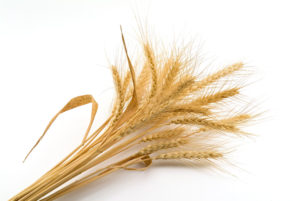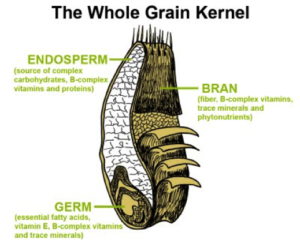Whole grain. Whole wheat. Multigrain. Aren’t they all the same? We know that all breads are not created equal. That is why we stopped buying white bread years ago, but what about all of these other choices? Navigating the bread aisle can be a challenge, especially when all these choices sound healthy. Well, here are some tips on how to choose bread that is good for your body and hopefully will make navigating the bread aisle a little easier next time.
Whole Grain: Whole grain means that it contains all the parts of the original grain kernel (the bran, the germ, and the endosperm). Each of these three parts contain different nutrients that offer something special for your body. The bran is the outside of the grain and contains dietary fiber, vitamins, and minerals. The endosperm is the middle of the grain and contains carbohydrates, protein, and vitamins. This is what refined flour is made out of- the bulkiest and least nutritious part of the grain. The inner layer is the germ, which offers nutrients, vitamins, and antioxidants.
Why choose Whole Grains?
Whole grains offer a wide range of nutrients, dietary fiber and other healthy compounds found in the grain, naturally. When the bran and germ are removed, the bread becomes significantly less nutritious. Whole grains help reduce the risk of heart disease, reduce constipation, and can help with a healthy pregnancy.
The dietary fiber found in whole grains can help reduce blood cholesterol and lower your risk for heart disease, obesity, and type 2 diabetes. Whole grains also act as prebiotics which feed the beneficial bacteria in your gut, enhancing your microbiome. The B-vitamins help your body use the energy found in the protein, fat, and carbohydrates, and create a healthy nervous system. Folate, one specific B-vitamin, helps to form red blood cells in the body while the iron found in whole grains help carry oxygen in the blood. Selenium, an antioxidant and mineral, helps create a healthy immune system.
Whole Wheat: Whole wheat is a specific type of whole grain, which contains the entire wheat grain.
Multigrain: Multigrain means the bread contains more than one kind of grain- wheat, barley, quinoa, oats, etc.; however, it does not necessarily mean more nutritious. Unless it specifically says whole multigrain the bran and germ have been removed, which in turn removes nutrients.
The Importance of 100% Whole Grain or Whole Wheat
An important thing to remember is to check for the 100% whole grain or whole wheat stamp (shown above) to ensure that you are getting the healthiest option.
It is tricky, we know. But choosing 100% whole grain or whole wheat bread is an important and healthy choice to make. Adults should eat three 1-ounce servings of whole grains a day and choosing 100% whole grain or whole wheat is an easy and healthy way to meet these serving guidelines.
Buying Bread
Not all loaves are created equal. When shopping for bread, read the label. Compare brands for calories, dietary fiber, sugar, and sodium. Choose organic to avoid high fructose corn syrup. And, the higher the fiber the better and low in sugar and sodium. Download the Fooducate app (free) on your phone and scan bar codes to find a healthy bread you can enjoy, guilt-free.




Comments